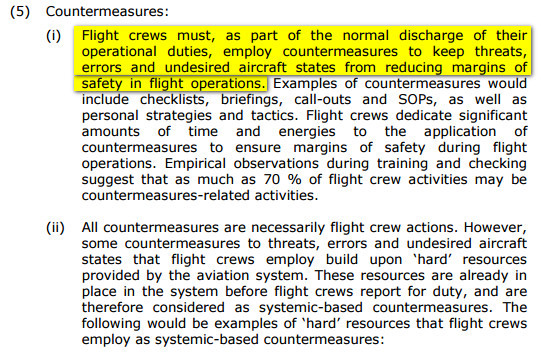mh wrote:
Plus, a high level of standardisation and process control dramatically reduced airline accident and fatality rates over the years.
I never believed that. Accident and fatality rate was dramatically reduced by higher levels of automation, better and more reliable aircraft systems, envelope protection and safety measures like TCAS and EGPWS (collision warning and ground proximity warning systems), better ATC radars and so on. To a degree that almost every transport category aircraft accident is now caused by the crew – notwithstanding TEM, CRM (company resource management), SMS (safety management system) and all the remainig paper tigers they have set on us during the last two decades.
Thanks for that link WN.
What a load of complete bollox…

Gosh, I thought the pilot jumps in, starts up, and flies off…
This is like the ISO9000 bollox we get at work: “do you segregate defective materials?”. NO SIR we mix them up with the good stuff and send the whole lot out!
Maybe there are examples of how this helps in the cockpit, but it isn’t evident from that EASA verbiage, which is like the JAA ATPL HP&L subject matter – packed with invented (and occassionally discredited) psychological models.
Peter wrote:
Maybe there are examples of how this helps in the cockpit,
No.
what_next wrote:
These guys will fail you for poor flying and practical instructing skills but never for poor bla-bla
LOL 
From Wikipedia (for what it’s worth)
Airmanship is skill and knowledge applied to aerial navigation, similar to seamanship in maritime navigation. Airmanship covers a broad range of desirable behaviors and abilities in an aviator. It is not simply a measure of skill or technique, but also a measure of a pilot’s awareness of the aircraft, the environment in which it operates, and of his own capabilities.1
Airmanship can be defined as:2
A sound acquaintance with the principles of flight,
The ability to operate an airplane with competence and precision both on the ground and in the air, and
The exercise of sound judgment that results in optimal operational safety and efficiency.
The three fundamental principles of expert airmanship are skill, proficiency, and the discipline to apply them in a safe and efficient manner.3 Discipline is the foundation of airmanship.4 The complexity of the aviation environment demands a foundation of solid airmanship, and a healthy, positive approach to combating pilot error.5
IMO it’s important to remember that airmanship exists exclusively inside a pilot’s head. It’s not an array of acronyms explained in countless pages on obscure web pages. Airmanship is what’s left of knowledge and experience, usable to exercise sound judgement when flying. Not too long ago I remember there was lots of focus on “attitude” when talking about airmanship. A pilot should learn to have the correct “attitude” towards safety etc. Of course that also was a load of bull, it’s skills and judgement that keeps aircraft from falling from the skies, along with a healthy dose of self preservation and the will to preserve others.
I prefer CMN SNS.
The sheer number of conpletely different frameworks in the human factors ATPL syllabus is almost amusing. Every few years there is a new fad…
Maybe there are examples of how this helps in the cockpit,
No.
So how can anybody make use of it?
LeSving wrote:
IMO it’s important to remember that airmanship exists exclusively inside a pilot’s head. It’s not an array of acronyms explained in countless pages on obscure web pages. Airmanship is what’s left of knowledge and experience, usable to exercise sound judgement when flying. Not too long ago I remember there was lots of focus on “attitude” when talking about airmanship. A pilot should learn to have the correct “attitude” towards safety etc. Of course that also was a load of bull, it’s skills and judgement that keeps aircraft from falling from the skies, along with a healthy dose of self preservation and the will to preserve others.
I would guess that the “load of bull” is an attempt to teach airmanship, as opposed to achieving it by a combination of natural aptitude and experience.
It makes good sense to me, at least when you are talking about integrated ATPL courses.
I remember in the mid 80s, when CRM (Cockpit/Crew Resource Management) was still a new concept. Lots of people were vehemently opposed to it. Claiming it was a “load of bull”, “meaningless acronym”, “taking away the authority of the captain” etc. etc. Not very different “arguments” from what I can read in this thread.
Today CRM is such a well-established concept that two-pilot operations without it would be unthinkable and many of the ideas have found their way into single-pilot operations.
Yes but without concrete examples, one is just debating concepts.
Can somebody also explain what TREATS is supposed to mean?
Peter wrote:
Can somebody also explain what TREATS is supposed to mean?
I suspect it is simply a misspelling of “Threats”. The very first post in this thread said
I certainly don’t like introducing it for the first few airborne exercises. Some person is on their first lesson and line 3 on your board brief is TREATS.Replace TREATS with “threats” (capitalised for emphasis) and the passage makes perfect sense.
From another posting:
Treats – would be other aircraft
This is clearly a misspelling.